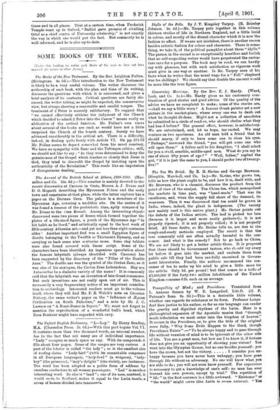The Tea We Drink. By E. H. Skrine and George
Brownen. (Simpkin, Marshall, and Co. ls.)—Mr. Skrine, who grows tea, tells us how the plant ought to he, and how it is, dealt with, and Mr. Brownen, who is a chemist, discusses the product from the point of view of the analyst. The China tea, which monopolised the markets in time past, was "hand-made." That was its excellence, and, when the supply fell short of the demand, its weakness. Then it was discovered that tea could be grown in India, where, indeed, the plant is indigenous. (The variety now mainly used is this native plant) Mr. Skrine points out the defects of the Indian article. The leaf is picked too late (because it is larger and more easily gathered); it is not properly ripened; it is not properly rolled ; it is not properly dried. All these faults, so Mr. Skrine tells us, are due to the rough-and-ready methods employed. The result is that the teas commonly sold are often actually harmful to the con- sumer. And what is the remedy ? Not to go bask to China. We are not likely to get a better article there. It is proposed that there should be Government tasters, who should try every lot before it goes into the market, and exclude them from public sale till they had been carefully examined in Govern- ment laboratories. Finally, the authors recommend the con- sumer of tea to make up his mind to give a little more for the article. Only 3d. per pound ! but that comes to a trifle of £9,500,000 if the forty-two million inhabitants of the United Kingdom consume 6 lb. each on an average.






































 Previous page
Previous page